|
|
|
Sort Order |
|
|
|
Items / Page
|
|
|
|
|
|
|
| Srl | Item |
| 1 |
ID:
183195
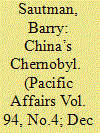

|
|
|
|
|
| Summary/Abstract |
In COVID-19’s first months, US politicians and media forecast that a contrast between Chinese deception and incapability and Western success against the pandemic might fatally sink internal confidence in China’s party-state. It would also diminish China externally, as it came to be seen as endangering the world by spreading biological pollution. A “China’s Chernobyl” prediction became the latest “China collapse” wish-fulfilment. This rests on two contradictory yet co-existing Yellow Peril tropes: “deceit and incompetence” and “world domination.” However, no empirical basis exists for either notion: China prevailed against the pandemic and lacks the capacity for global hegemony. “China’s Chernobyl” is most relevant then as a wish that creates a belief, that China should and could collapse. That in turn bolsters the US-led mobilization to counter China as a “strong competitor” and frames China as the common enemy, thereby promoting Western transnational and US internal cohesion.
|
|
|
|
|
|
|
|
|
|
|
|
|
|
|
|
| 2 |
ID:
166618
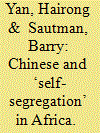

|
|
|
|
|
| Summary/Abstract |
Chinese are often said to ‘self-segregate’ in Africa. Chinese ethnocentricity is typically offered as an explanation for the putative non-interaction. Meanwhile Chinese are not compared to other non-indigenous people in Africa, implying unique Chinese self-isolation. Due to China’s semi-peripheral dynamics however, the contemporary Chinese presence in Africa cannot be generalized into a single category. Based on surveys, interviews, and documents, we examine the varied presence of Chinese in Africa, including residential patterns acquisition of local African languages, and socialization patterns, and draw distinctions between Chinese expatriates and Chinese migrants. Factors affecting Chinese adaptation include local political environment, recentness of migration, language barriers, and corporate policies to mitigate crime and conflict. We argue that most Chinese in Africa are not self-isolated and not more isolated in Africa than are other Asian migrants and whites there. Claims of Chinese self-isolation reflect a longstanding, global Yellow Peril discourse that persists despite discrediting evidence.
|
|
|
|
|
|
|
|
|
|
|
|
|
|
|
|
| 3 |
ID:
158057
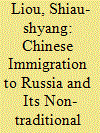

|
|
|
|
|
| Summary/Abstract |
Russia and China rapidly restore communication after the Cold War, but the Chinese immigration issue is also widely exaggerated and even described as “Yellow Peril again” in Russia. The so-called Yellow Peril is not only a Russian object perception but also a cross-generational conflict between Russia and China. Furthermore, it will be related to the subsequent development of the Russian Far East and Siberia. The Chinese immigration constitutes psychological and survival non-traditional security impacts on Russia and also forms some kind of social competition with Russians. It is vital for Russia to cooperate with its eastern neighbor to accelerate the development of the Russian Far East and Siberia, but national security and social stability are the prerequisites for cooperation. Nevertheless, it is more significant to rebuild self-confidence of the Russians in the Russian Far East and acknowledge that the East will not be a threat to Russia. As long as Russia realizes that it can enjoy unlimited possibilities in the East, the non-traditional security impacts caused by the Chinese immigration will automatically alleviate and even disappear. Today, most Russians are trapped in the dilemma of welcoming or refusing the Chinese immigrants; however, cultural exchange still has some effects and at least causes Russians to begin to positively treat the Chinese immigration and consider whether to accept China and cooperate with China.
|
|
|
|
|
|
|
|
|
|
|
|
|
|
|
|
| 4 |
ID:
138592
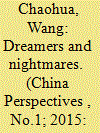

|
|
|
|
|
| Summary/Abstract |
Wang Lixiong’s Yellow Peril (1991) represents the return of political fiction of the future not seen in China for decades. Chan Koonchung’s The Fat Years (2009) brings the imagination to a full dystopian vision. Reading the two novels side by side, this paper argues that Chinese fiction of the future in the early 1990s responded to the country’s struggle for direction when the bloody crackdown of the Tiananmen protest wiped out collective idealism in society. In the twenty-first century, such fiction is written in response to China’s rapid rise as one of the world’s superpowers, bringing to domestic society a seemingly stabilised order that has deprived it of intellectual vision.
|
|
|
|
|
|
|
|
|
|
|
|
|
|
|
|
| 5 |
ID:
092416
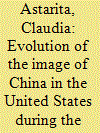

|
|
|
|
|
| Publication |
2009.
|
| Summary/Abstract |
This article describes the evolution of the image of China in the United States (US) during the Cold War. Aware that China-US bilateral relations have been influenced by periods of conflict and animosity, harmony and détente, the article argues that the image of China has always been embedded in a network of events-birth of the PRC (People's Republic of China [PRC], Korean War, Sino-Soviet alliance) that prevented American public opinion from developing an objective and unbiased picture of the PRC. Since 1950s, China has always been linked to the idea of the 'Yellow Peril'. Moreover, the lack of a direct contact between China and America further thwarted the opportunity of shaping a fair picture of the PRC. Although recognising that during the Cold War American political parties played a significant role in conveying a negative image of China, this article shows how media helped in strengthening Chinese stereotypes among the American public. Analysing all articles published by Time, National Geographic and Readers' Digest from 1949 to 1972, the article highlights both similarities and differences of the way in which these magazines introduced China to their readers.
|
|
|
|
|
|
|
|
|
|
|
|
|
|
|
|
| 6 |
ID:
173170
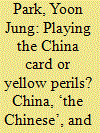

|
|
|
|
|
| Summary/Abstract |
Over the past several years there have been a number of racially-tinged incidents in South Africa involving ‘the Chinese.’ Simultaneously, the love affair between Chinese and South African government leaders has expanded to include local Chinese community leaders and local ANC officials. Based on ongoing research on Chinese communities in South Africa I examine these conflicting phenomena and explore the various ways in which the three main ethnic Chinese communities – Chinese South African, Taiwanese South African, and mainland Chinese migrant – and other South Africans respond to these often conflicting social and political messages. I argue that China’s global ascendance and South Africa’s increasing national-level dependence on China encourages some actors (both Chinese and non-Chinese) to opportunistically wield the China card while other non-Chinese South Africans respond with fear and racism, invoking Yellow Peril narratives.
|
|
|
|
|
|
|
|
|
|
|
|
|
|
|
|
|
|
|
|
|